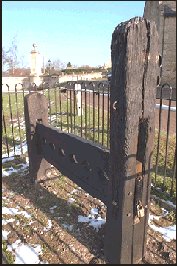
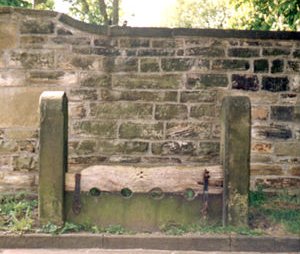
Villages and small towns would rarely have a jail. So someone
arrested for a serious crime would be held in the stocks, as the only means of secure confinement
available. He or she would remain there until they could be brought to trial, either to a court
in a large town or by a visiting judge.


Stocks could be used in prisons to restrain prisoners, as an alternative to manacles and fetters. This picture shows Thomas Leyes, William Andrew, John Wade and George King in the Lollard's Tower in 1555. This was a private jail in Lambeth Palace, London, the residence of the Archbishops of Canterbury. These prisoners were Protestants who were persecuted by (the Catholic) Queen Mary I, also known as "Bloody Mary". They all died in prison; possibly from natural causes, although Queen Mary did not hesitate to use torture on Protestant prisoners. If they had survived, they would have been burnt at the stake, as were hundreds of other Protestants during Bloody Mary's reign.
Stocks were a common punishment in workhouses, which were 19th century "benevolent" institutions for the poor. Failure to obey the strict and numerous rules could entail a spell in the stocks.
Stocks and pillories were also employed in torture chambers, to restrain victims during or between torture sessions.

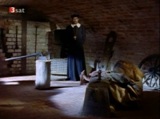
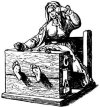
Stocks sometimes formed part of a torture instrument, for example to immobilise the victim’s ankles while he or she was being stretched on the rack. Here are some illustrations of other instruments of torture which incorporated stocks.
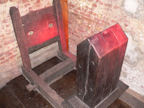 With this device the victim’s feet would be secured in
the stocks, while the hands were manacled to the other end, leaving him or her bent backwards
over the large wedge in the middle.
With this device the victim’s feet would be secured in
the stocks, while the hands were manacled to the other end, leaving him or her bent backwards
over the large wedge in the middle.
|
 As if this was not enough, a funnel would be inserted into
the victim's mouth, into which would be poured a considerable quantity of water.
As if this was not enough, a funnel would be inserted into
the victim's mouth, into which would be poured a considerable quantity of water.
|
 The throne in use by the Holy Inquisition. The edge of the throne forces the victim's spine to bend backwards.
The throne in use by the Holy Inquisition. The edge of the throne forces the victim's spine to bend backwards.
|
 The victim sits in the stocks, while hot coals are placed under his feet.
The victim sits in the stocks, while hot coals are placed under his feet.
|
